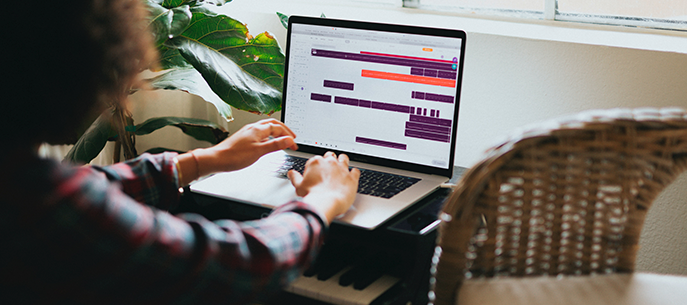
The Beginner’s Guide to the DAW
September 26, 2023In an era where technology and music intertwine more intimately than ever, the digital audio workstation, or DAW, emerges as the heartbeat of modern music production. Gone are the days when creating music required vast studios and bank-breaking equipment. Today, with just a computer and a DAW, the songs that echo in your head can be brought to life, shared, and even transformed into chart-topping hits.
At its core, music creation is a blend of art and technology — and the tools used to craft melodies and rhythms have seen substantial evolution over the years. At the heart of this tech-infused musical revolution is the digital audio workstation.
If you’re new to this revolutionary tool or looking to understand its vast potential, you’re in the right place. Welcome to “The Beginner’s Guide to the DAW,” where we’ll embark on a journey through the digital landscape that’s shaping the music of today and tomorrow. Whether you’re an aspiring artist, a budding producer, or simply a music enthusiast, by the end of this guide, the intricate world of DAWs will feel like home. Let’s dive in!
What Is a DAW and Why Does It Matter?
A digital audio workstation (DAW) is a software application or electronic system specifically designed for recording, editing, and producing audio files. DAWs can be used to craft complex music compositions, record podcasts, or produce sound for film, among other functions.
The importance of DAWs in modern music production can’t be overstated. They provide musicians and producers with the flexibility to manipulate sound in ways previously considered impossible or requiring expensive studio equipment. From a bedroom music enthusiast to professional studios, a DAW has become an indispensable tool, democratizing music production by making it more accessible.
Read More: What is a DAW, and Why Does it Matter?
The Evolution of DAWs
The journey of DAWs is a fascinating one. Before the advent of the digital age, music was primarily recorded in analog tape studios. These studios were equipped with large mixing desks and reel-to-reel tape machines. While they provided an authentic sound, they were cumbersome, expensive, and lacked the flexibility of modern systems.
The transition from these analog systems to computer-based digital workstations started in the late 20th century. As computers became more powerful and affordable, software developers began crafting programs that could mimic — and soon surpass — the capabilities of traditional tape studios. The first DAWs were rudimentary and limited by the technology of the time. But rapid advancements in computing power, storage capabilities, and software design soon transformed them.
Today, DAWs offer a plethora of features, from virtual instruments that emulate classic synthesizers to advanced plugins that can manipulate sound in almost any conceivable way. They also allow for collaborative projects where musicians from different parts of the world can work on a track simultaneously, a feature unthinkable in the era of tape studios.
Why Every Music Maker Should Learn About DAWs
Wondering if a DAW is the right choice for you? Consider the many benefits of working with this revolutionary technological tool.
Versatility in Music Production
DAWs have revolutionized the music-making process, enabling a broad spectrum of capabilities that were once segmented and out of reach for many musicians.
- Crafting Beats: Drum machines or physical drummers are no longer the only sources of rhythm. With a DAW, musicians can use digital drum pads, sequence beats, or even employ algorithms to generate unique rhythms.
- Recording Live Instruments: While traditional recording is a cherished process, DAWs offer flexibility by allowing multiple takes, easy edits, and seamless integration with digital elements. For instance, a guitarist can play a riff, loop it, and then experiment with various effects without needing a plethora of pedals.
- Virtual Instruments: From grand pianos to esoteric synthesizers, DAWs come equipped with virtual instruments that replicate countless sounds, broadening a musician’s sound palette without the need to purchase and store physical instruments.
- Mixing and Mastering: DAWs aren’t just for creating; they’re also for refining. Musicians can balance track levels, pan instruments, and add professional-grade effects to ensure their track sounds polished and ready for release.
Cost-Effective Home Studios
Traditional music studios, with their vast arrays of equipment, sound engineers, and hourly rates, can be an expensive endeavor. DAWs, however, have shifted this dynamic significantly.
- Initial Setup: Investing in a quality DAW might seem like a significant upfront cost, but it’s a fraction of what a professional studio setup would demand. Moreover, with many DAWs offering subscription models or even free versions, there’s a lower barrier to entry.
- No Hourly Studio Rates: Renting studio time adds up. With a DAW, you simply pay once or choose a subscription plan. Then, you can create endlessly without watching the clock. Late-night inspiration? No need to book a studio. Just fire up your DAW.
- Limitless Experimentation: In a rented studio, time is literally money. At home, with a DAW, musicians can experiment, take breaks, and come back to their work without financial pressure. This often leads to more genuine and creative outcomes.
- Expanding Over Time: Starting with a basic DAW setup, musicians can expand their home studio as they go. Whether it’s adding a new plugin, virtual instrument, or an external piece of hardware, it’s a modular approach that can grow with one’s needs and budget.
The Key Features of a DAW
As the heart of any modern music production setup, a DAW provides a feature-rich environment and a plethora of tools that collectively shape the music-making process. Here are some of the most salient features of DAWs, and why they are indispensable to contemporary musicians.
Multi-Track Recording
Multi-track recording allows musicians to record multiple sources of audio separately, enabling individual manipulation of each track.
What it is: Envision recording each instrument in a band separately, then blending them perfectly. That’s the essence of multi-track recording. Each instrument or vocal is recorded on its own track, providing isolation and individual control.
Why it’s a game-changer: Before this technology, musicians had to perform perfectly in one go. With multi-tracking:
- Mistakes can be corrected without re-recording the entire song.
- Each track can be edited, processed, and mixed individually.
- Layers can be added or removed, offering unparalleled creative freedom.
MIDI Capability
MIDI, or “musical instrument digital interface,” is a protocol that allows musical instruments and computers to communicate.
The Basics of MIDI: Unlike regular audio files, MIDI doesn’t contain sound. Instead, it captures the performance data (like note duration, pitch, and velocity) and sends this information to software instruments or synthesizers to produce sound.
Its Applications:
- Composition: Musicians can use MIDI to compose, ensuring that every note is perfectly placed.
- Electronic Instruments: Keyboards, drum machines, and even wind instruments can be used to input performance data.
- Sequencing: Create patterns, beats, and full compositions by placing MIDI notes on a sequencer within the DAW.
Mixing and Mastering Tools
Once the recording phase concludes, the DAW offers an array of sophisticated tools to perfect the sound, bringing out the nuances, ensuring clarity, and adding a professional finish to your tracks.
- Equalizers: These are akin to the painter’s palette for a music producer. Equalizers allow you to shape the frequency content of a track, boosting or cutting specific frequencies to achieve clarity, balance, and ensure each instrument sits well in the mix. From brightening vocals to making the bass resonate, it’s a tool of endless possibilities.
- Compressors: Think of these as the guardians of consistency. Compressors help control the dynamic range of audio, ensuring that volume levels are consistent, punchy, and free from unexpected peaks or dips. They can make vocals stand out, drums hit harder, and generally ensure your track feels cohesive.
- Reverb and Delay: These tools are the magic wands of sound design within a DAW. They add space and depth to recordings, creating everything from subtle ambiances to vast soundscapes. Whether you’re aiming for the intimate feel of a small room or the echoing vastness of a cathedral, reverb and delay can take you there.
In essence, a DAW is more than just recording software—it’s an entire ecosystem tailored to capture, enhance, and perfect the musical vision of its user. Whether you’re an aspiring musician or a seasoned producer, understanding and leveraging the features of a DAW is paramount to achieving professional sound.
Choosing the Best DAW for Your Needs
Before you start creating, you’ll need to choose a DAW that helps you express yourself, your way! Instead of purchasing the first DAW you see, take the following into consideration:
- Platform Compatibility: Not every DAW is available for all platforms. Before investing time or money, ensure the software you’re considering is compatible with your operating system, whether it’s macOS, Windows, or even Linux.
- Budget Considerations: DAWs range from free to quite pricey. Establish your budget first. Some premium DAWs offer limited free versions that can be a good starting point, while others might provide monthly subscription models.
- Genre-Specific Features: Depending on the genre of music you’re planning to produce, certain DAWs may be more tailored to your needs. For instance, some might cater more to electronic music producers with extensive synthesizer libraries, while others could be designed for recording live instruments.
Once you know what you’re looking for, you can make an informed decision and choose the best DAW for your needs, whether you’re a student or an experienced producer.
Selecting the Best DAW as a Beginner
When you’re new to the music-making game, it can be overwhelming to choose from so many different DAWs. Sometimes, it’s better to start with a DAW that’s easy and intuitive for beginners to use. For instance, DAWs like Soundtrap for Education are so easy to use that even young children can hop in the Soundtrap Studio and start creating.
- User-Friendly Interface: Soundtrap offers an intuitive interface that doesn’t overwhelm users with too many options right from the start.
- Collaboration: One of its standout features is the ability to collaborate with others in real time, which is a boon for artists working with remote teams or partners.
- Cloud-Based: No need to worry about storage or accessing your projects from different devices. Everything is stored safely in the cloud.
- Built-in Loops and Instruments: For those just starting, Soundtrap offers a wide range of built-in loops and instruments, eliminating the need to find and buy sound packs.
- Affordability: With a tiered subscription model, Soundtrap is accessible for those on a budget, and its premium features can always be explored later as one grows.
The Importance of User Interface and Workflow
Choosing a DAW is not just about its features or compatibility; it’s also about how you interact with it. A good user interface (UI) can make the difference between a smooth creative process and a frustrating one.
- Intuitive Design: A good DAW should be easy to navigate, allowing users to focus more on creating music than searching for the right tool or function.
- Customizability: As you become more familiar with your DAW, you might have a preferred setup or layout. The ability to customize the interface to your liking can speed up your workflow significantly.
- Smooth Workflow: DAWs should streamline the music-making process, allowing for quick edits, easy access to tools, and efficient track layering.
- Learning Curve: A steep learning curve might deter beginners. Opt for a DAW that offers ample tutorials and has a robust online community for support.
Basic Recording Techniques for Beginners
You’ll need to set up your recording space before you start creating, but it’s easier than you might think! Here’s how to get started with recording in your DAW.
- Setting Up Your Input: Whether you’re using a microphone or an instrument, ensure it’s connected to your audio interface and selected as the input source in your DAW.
- Monitoring: Use headphones to listen to your input in real time without any latency or delay. This can often be toggled on or off in the track’s settings.
- Record Arm: Before recording, you’ll need to “arm” the track, usually indicated by a red record button on the track itself.
- Multiple Takes: Don’t stress about getting the perfect take on your first try. Most DAWs allow for multiple takes, letting you choose the best one.
- Metronome: For timing accuracy, especially when not recording to a backing track, use a metronome to keep a steady beat.
Starting your journey with a DAW might feel overwhelming at first, but with time and practice, the process will become intuitive. Remember to always experiment and have fun while learning!
How to Make Music with a DAW
Making music with a DAW is easier than you might think, especially when you have plenty of tutorials to guide you along the way. With these simple tips, you can make music like never before. Let’s get started!
1. Get Started with a Beat
The beat is the backbone of your song, so it’s a great place to get started! Although many songwriters prefer to begin creating their song with the melody in mind, the beat is often the first part they create in their DAW. At the heart of most music lies a compelling beat or rhythm, which requires the following:
- Drum Sequencing: Many DAWs come with a built-in drum machine or sequencer. Begin by laying down a basic kick, snare, and hi-hat pattern. Adjust and modify as you see fit.
- Loops: If you’re not keen on programming your beats, many DAWs offer pre-made drum loops that you can drag, drop, and tailor to your song’s vibe.
2. Laying Down Melodies and Harmonies
Now that you’ve created your beat, create your melody and harmonize the tracks! These tools will help you along the way:
- Virtual Instruments: DAWs typically come packed with a variety of instruments, from synthesizers to string sections. Use a MIDI keyboard or your computer’s keyboard to play and record melodies.
- Sampling: Another popular technique in modern music is to use samples. These can be short clips of other songs, vocal snippets, or any sound you can imagine. Most DAWs have a sampler tool to help pitch, chop, and rearrange samples.
3. Adding Bass and Low-End Elements
Next, fill out your song with bass lines. The bass acts as the anchor, providing depth and groove.
- Bass Lines: Using a bass VST (virtual studio technology) plugin or real bass guitar, create a rhythmically compelling and harmonically rich bassline that complements your beat and melody.
- Sub-Bass: For genres like hip-hop or EDM, deep sub-bass can add a layer of richness. This can often be achieved with a simple sine wave on a synthesizer.
4. Incorporating Vocals
For many songs, the vocals are the centerpiece of the track — especially if you’re a talented lyricist. Follow these tips to tell your story even better.
- Recording: Ensure you have a quiet space, a good microphone, and a pop filter. Record multiple takes for more flexibility during the editing phase.
- Layering: For a fuller sound, record multiple layers or harmonies. This can give a professional sheen to your choruses or key moments.
- Effects: Add reverb for space, compression for consistency, and EQ to ensure clarity in your mix.
5. Mixing and Effects
Mixing and adding a few effects will round out your song while ensuring a polished final project. Add these effects to give each element its space:
- Equalization (EQ): Use EQ to boost or cut frequencies, ensuring each track can be heard without muddying the overall sound.
- Compression: This reduces the dynamic range, ensuring consistent volumes and adding punch to certain instruments like drums.
- Reverb and Delay: These effects add depth and space to your tracks. They can make elements sound like they’re in specific environments, from small rooms to massive halls.
- Panning: Spread your tracks from left to right for a wider stereo image.
6. Mastering and Final Touches
Mixing and mastering are similar, but they’re not quite the same. Mastering is much less intensive than mixing, but it will help you prepare your song for distribution. This final step in music production includes the following:
- Limiting: Ensure your track’s volume matches industry standards without distorting.
- EQ Tweaks: Make any final adjustments to the overall sound.
- Stereo Widening: Techniques like mid/side EQ can help your track sound bigger and more polished.
- Exporting: Once you’re satisfied, export your track in the desired format (usually WAV or MP3), ensuring the highest possible quality.
Read More: How to Make Music with a DAW
Create Your Musical Masterpiece with Soundtrap for Education
Soundtrap for Education is the ultimate audio production platform for students and teachers to create and edit audio recordings. Pupils and educators can easily tap into their artistic side with this intuitive audio platform that facilitates a creative learning environment for every subject, regardless of the student’s age or experience level.
With Soundtrap for Education, students and teachers can collaborate with advanced cloud technology at any time or place. In addition, the platform comes equipped with a robust resource portal, with tutorials, an external curriculum, and lesson plans to complete the educational experience. And to ensure privacy, teachers can keep student collaboration safe and secure with invite-only groups in Soundtrap’s versatile digital environment.
If you’re ready to enhance your educational experience with an intuitive cloud-based audio production platform, start with Soundtrap for Education! And be sure to share this article with other teachers in your network to help spread the joy of learning through sound.
 EDU Portal
EDU Portal


